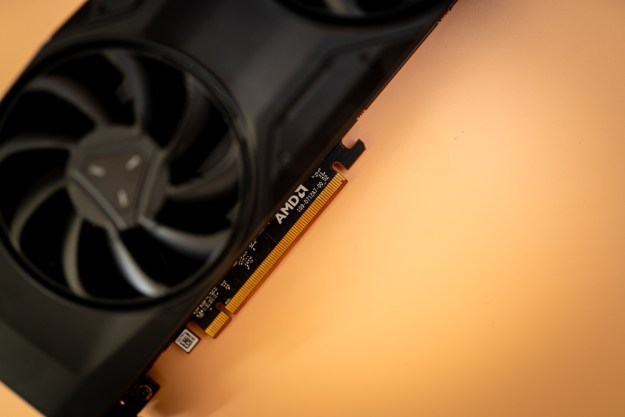ASRock has prematurely released the full specifications of AMD’s as-yet-unannounced midrange new-generation graphics card, the RX 5600 XT. It will have the same number of stream processors as the RX 5700, but with lower clock speeds and less memory. This all but confirms it will compete with the likes of Nvidia’s GTX 1660 Super and Ti, replacing the aged and increasingly-hard-to-find Vega 56.
AMD has needed to flesh out its RX 5000-series ever since its debut with just two cards in July 2019. As capable and as competitive with Nvidia’s midrange RTX GPUs as they are, RX 5700 and 5700 XT didn’t go far in updating AMD’s graphics card lineup. The RX 5500 XT debuted on December 12, and now it looks like the 5600 XT will follow shortly after, further expanding the range and offering greater competition for Nvidia’s 16-series GPUs.
The original information leak appeared on Reddit, but has since been deleted. VideoCardz managed to grab all of the important details, however, so we know that ASRock’s 5600 XT Challenger OC will have 2,304 stream processors (the same number as the RX 5700), but with lower clock speeds.
| RX 5700 XT | RX 5700 | RX 5600 XT | RX 5500 XT | |
| Stream processors | 2560 | 2,304 | 2,304 | 1,408 |
| Base clock | 1,605MHz | 1,465MHz | 1,235MHz | 1,607Mhz |
| Game clock | 1,755MHz | 1,625MHz | 1,460MHz | 1,717MHz |
| Boost clock | 1,905MHz | 1,725MHz | 1,620MHz | 1,845MHz |
| Memory | 8GB GDDR6 @ 14 Gbps | 8GB GDDR6 @ 14 Gbps | 6GB GDDR6 @ 12 Gbps | 4GB/8GB GDDR6 @ 14 Gbps |
| Memory bus | 256-bit | 256-bit | 192-bit | 128-bit |
| Memory bandwidth | 448GBps | 448GBps | 288GBps | 224GBps |
The 5600 XT is an intriguing GPU. With only clock speed really differentiating the cores, it’s possible that overclocking on a card with good cooling could significantly narrow the performance gap between it and the 5700. That said, memory bandwidth could be a problem with the 5600 XT. With just 6GB of GDDR6 at 12 Gbps, it actually has less, and slower memory than the 5500 XT. Its greater memory bus helps its bandwidth, but with 35% less than the 5700, that’s where the performance gap will be felt the most. Memory overclocking could be a major focus for those looking to get the most from their 5600 XT.
These specifications can be generally trusted as an accurate interpretation of the reference 5600 XT, but since this card is ASRock’s own factory overclocked and tweaked model (the Challenger OC) it is likely that there will be some alterations in clock speeds, involving the game clock in particular. It’s quite likely that higher clocked versions will be available from other manufacturers, or even with alternate versions of ASRock’s own designs.
In any case, the performance of the 5600 XT should put it right in the middle of the pack. Some allegedly leaked 3DMark test results from earlier in December suggest it will be slightly faster than an AMD Vega 56, which would put the 5600 XT a little ahead of Nvidia’s GTX 1660 Ti, and a little behind the RTX 2060.
That’s still speculative as there are still no verified third-party (or even first-party) benchmarks of this card, especially when paired with modern hardware, but it seems likely considering where AMD has positioned its existing lineup in the market. Pricing will be the key with the 5600 XT. Where the 5500 XT managed to slightly outperform its competition (GTX 1650 Super) at a slightly inflated price, we wouldn’t be surprised to see the 5600 XT do much the same. With the 5700 sitting just north of $350 and the 5500 XT just north of $200, a $280-$300 price tag for the 5600 XT seems reasonable to expect.
With CES 2020 just weeks away, it’s possible that we’ll see the 5600 XT debut there, with an early 2020 release, ahead of a possible “big-Navi” unveiling later in the year. That leaves plenty of room for Nvidia to reposition itself ahead of its next-generation Ampere graphics line later in 2020, but with rumors of its delay, it may be some time still before we see any new, high-end graphics cards from either the red or green team.
Editors' Recommendations
- AMD’s RX 7600 XT might be dead on arrival — but there’s a catch
- Here’s how AMD counters Nvidia’s big RTX Super launch
- AMD has another new GPU that it says can beat the RTX 4060 Ti
- AMD might still have some next-gen GPUs left in the tank — but I don’t buy it
- Nvidia gave AMD’s RX 7800 XT a free win





